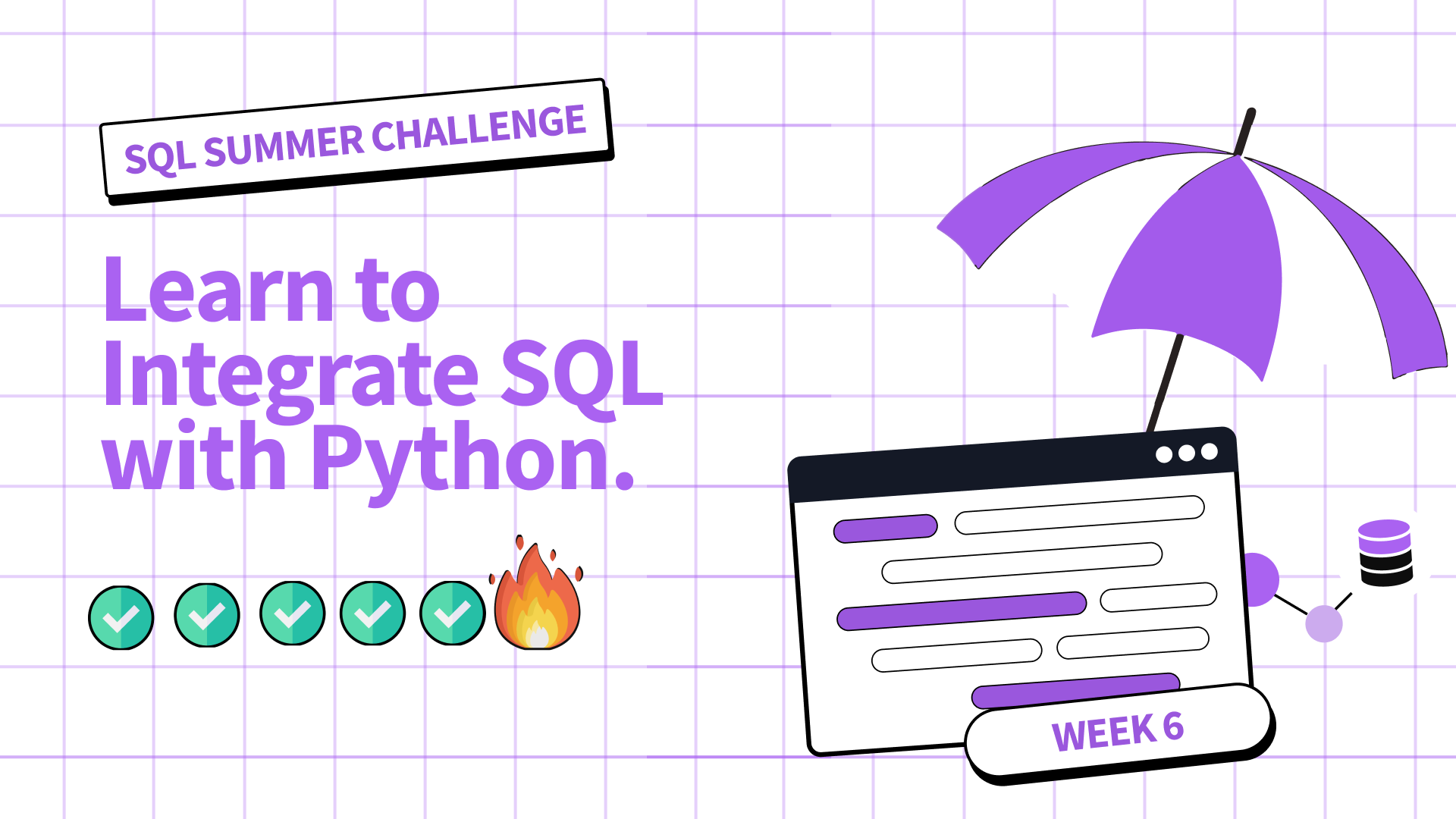The Dataquest Download
Level up your data and AI skills, one newsletter at a time.
Learn how to integrate SQL with Python
Hello, Dataquesters!
Welcome to our final installment of the SQL Summer Challenge. I’m excited to share with you an important skill in data analysis: integrating SQL with Python. Whether you’re new to Dataquest or have been with us from the start, this week’s focus on SQL-Python integration will take your data skills to the next level.
When I started working with data, I used SQL with R, which was a powerful combination. (You can learn more in this R course.) However, as I transitioned to using Python more, I discovered how well SQL and Python work together. This integration has transformed how we approach data analysis at Dataquest.
SQL excels at querying and managing large datasets, while Python is great for data manipulation and visualization. By combining them, you create a versatile toolkit for data analysis. It’s like having a comprehensive set of tools, each perfectly suited for specific tasks.
At Dataquest, we use this SQL-Python combination daily to analyze student progress and optimize our curriculum. For instance, we use SQL to extract data on course completion rates, then leverage Python’s pandas library to create visualizations that help us identify trends. This approach allows us to make informed decisions quickly and efficiently.
One tool that’s particularly useful for learning this integration is SQLite. Its lightweight nature makes it ideal for practicing and prototyping. In our Querying Databases with SQL and Python course, we use SQLite to teach you how to connect to databases, execute queries, and work with the results in Python.
Moreover, integrating SQL and Python opens up new possibilities in your data analysis. You’ll be able to handle larger datasets more efficiently, automate repetitive tasks, and create more sophisticated analyses. For example, you might use SQL to extract time-series data from a database, then use Python’s powerful libraries for predictive modeling. We’ve used this approach at Dataquest to predict student engagement and tailor our course recommendations.
Our students have landed jobs at top companies thanks to their SQL-Python skills. Industries from finance to healthcare to e-commerce are constantly seeking professionals who can bridge the gap between SQL databases and Python analysis.
As we wrap up our SQL Summer Challenge, I encourage you to apply these skills to your own projects. Perhaps you have a dataset you’ve been meaning to explore, or a problem at work that could benefit from this approach. The magic happens when you apply these skills to your own projects.
If you’re already comfortable with Python, you’ll find it easy to start querying SQL directly from your Python environment. Don’t worry if you’re new to Python though – our Data Analyst in Python path is designed to guide you from the basics all the way to advanced techniques.
So, how might integrating SQL and Python change your approach to data analysis? I’m curious to see what insights and solutions you’ll uncover with these powerful tools at your disposal.
If you’re interested in exploring SQL-Python integration further, our course is designed to take you from the basics of connecting to a database all the way to advanced data manipulation techniques.
As we close this chapter of our SQL journey, I want to thank you for joining us on this learning adventure. In our upcoming newsletters, we’ll be exploring data analysis with Python, building on the SQL foundation we’ve established. This focus on Python will help you further enhance your data analysis toolkit. Keep learning, keep exploring, and most importantly, keep asking questions. That’s where the real magic in data analysis happens!
Happy coding!
Casey
Week 6 SQL Summer Challenge

In the Querying Databases with SQL and Python course, learn the art of querying SQLite databases using Python and skillfully visualizing the results. This self-paced course consists of 1 lesson and takes only 2 hours to complete.
- Connecting to SQLite Databases: Learn how to connect to SQLite databases using Python.
- Querying Databases: Master the art of querying SQLite databases using Python.
- Data Manipulation with Pandas: Convert data from a SQLite database to a Pandas DataFrame for advanced data manipulation and analysis.
What We're Reading
📖 Google says Gemini AI is making its robots smarter
Google’s Gemini 1.5 Pro AI trains robots to navigate and complete tasks using video tours and natural language instructions, achieving a 90% success rate and demonstrating advanced planning capabilities. Read more
📖 Ask HN: Who is Hiring? (July 2024)
Browse through the latest job opportunities in the tech industry, featuring positions from various companies and locations, perfect for job seekers and recruiters alike. Read more
📖 Trying Kolmogorov-Arnold Networks in Practice
Gain insights into the practical application of Kolmogorov-Arnold Networks, a neural network architecture with potential implications for machine learning and data science. Read more
What's new
Give 20% Get $20
Now is the perfect time to share Dataquest with a friend. Gift a 20% discount, and for every friend who subscribes, earn a $20 bonus. Use your bonuses for digital gift cards, prepaid cards, or donate to charity. Your choice! Click here
Community highlights
Project Spotlight
Sharing and reviewing others’ projects is one of the best things you can do to sharpen your skills. Twice a month we will share a project from the community. The top pick wins a $20 gift card!
This edition, we spotlight Anatoly Sasedov‘s project on Star Wars Survey. He conducted a thorough and multifaceted analysis of the survey data and communicated his findings through awesome visualizations of the FiveThirtyEight style. The most noteworthy part of these visualizations is their titles and subtitles that exhaustively describe the obtained results.
|
Want your project in the spotlight? Share it in the community. |
|
Learner Tip of the Week
|
High-fives from Vik, Celeste, Casey, Anna P, Anna S, Anishta, Bruno, Elena, Mike, Daniel, and Brayan.